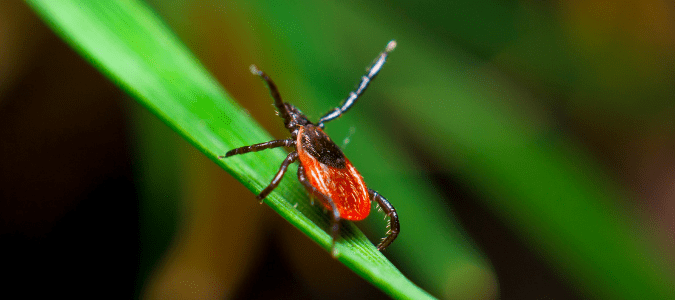Finding a tick crawling through your pet’s fur or fastened to its skin is no fun—for you, the pet or the tick. Finding a tick crawling on your own skin, or even embedded mid-bite? Now, that’s particularly cringe-worthy, especially if you’ve found the tick indoors, inside your home. What if you have a tick infestation somewhere in your house or yard? How long can ticks live in a house?
According to Alan Brown, Board Certified Entomologist and Technical Manager at ABC Home & Commercial Services, how long a tick can live in a home depends on what species of tick you’re dealing with. Most tick species can’t survive for very long in a home because they require a certain amount of humidity. These tick species will die inside a home after a couple of days. However, the brown dog tick can survive inside a home for long periods of time and can even breed and reproduce in a home. Theoretically, brown dog ticks could live inside your home for years. However, any other species cannot establish a population in your home.
If you believe you have found a brown dog tick in your home, or you’re not sure what kind of tick you’ve found, contact a pest control specialist. They can confirm what species of tick you’re dealing with and implement effective treatments.
Let’s explore several other common questions homeowners have about these parasitic creatures so that you can protect the members of your household from any potential risks.

How Long Do Ticks Live Without A Host?
To answer this question, let’s take a look at ticks’ biology—what makes a tick tick, if you will.
Many people think these critters are insects, but ticks are actually members of the arachnid class, along with spiders and scorpions. Like spiders, ticks have eight legs (except in their larval stage, when they have only six). Adult ticks are typically small, with flat, rounded bodies. Most measure less than a quarter-inch across and in length. They’re typically dark-reddish-brown or black in color, sometimes with light brown or grayish markings or a white spot on their backs. Many ticks can grow big and fat when they’re filled with blood after a long feeding, up to the size of a raisin, at which point their color may change to gray or dark reddish-blue.
Ticks have four stages of their life cycle—eggs, larvae, nymphs and adult ticks—and every stage except the eggs feeds on blood. This means that tick larvae and nymphs, as well as full-grown adult ticks, need to bite a host, such as a human or a wild animal, and suck its blood in order to survive. Ticks can feed off many types of animals, including birds, reptiles and even amphibians, as well as mammals. But how often do ticks need a blood meal, and how long do ticks live without a host?
Tick eggs are the first stage of the life cycle, and eggs do not feed on blood to survive. This means that when an adult female tick lays eggs, those eggs can live without a host for weeks until they hatch into larvae. Once a tick egg hatches, it has to feed on blood at every stage of its life cycle for the rest of its life in order to survive.
Ticks in the larval, nymph and adult stages can live for varying lengths of time without a blood meal—some for frighteningly long periods. American dog ticks, for example, a variety of tick that is common in North America and which feeds on not just dogs but also humans, cattle and other animals, can live for up to two years without a host!

Do Ticks Live In Trees?
Short answer: No, ticks do not live in trees. The thing about ticks is that they don’t fly, jump or even crawl very fast—and once they’ve hatched from their eggs into larvae, nymphs and adults, they need access to hosts for regular blood feedings. Since they have far better chances on the ground than in trees to find the hosts they need to survive, they aren’t likely to make the long, arduous journey of crawling up a tree trunk and into its branches to wait for a bird to land nearby.
When ticks do crawl, it’s typically along a host’s body in search of a good spot to settle down for a blood meal. So if you find a tick in your hair, it’s highly unlikely that it fell out of a tree and landed on your head. That being said, ticks can feed on birds, squirrels and other animals that spend time in trees. Furthermore, after a feeding session is complete, adult ticks will mate, and then the female ticks drop off the host’s body to lay their eggs on the ground. Between these two scenarios, it’s not completely out of the question that a tick could fall from an animal that happened to be in the branches of a tree, and fall onto another animal (or human) down below.
It’s far more likely, however, that you picked up a tick in the usual way—from walking through tall grasses, brush or other low-lying vegetation sometime during the late spring or early to mid-summer, which is high tick season in many parts of the U.S. The way many tick varieties, including black-legged and American dog ticks, find their hosts is by using their two backmost pairs of legs to cling to the tips of blades of grass while holding out their frontmost legs, in a move called “questing.” This move enables them to grab hold when a dog, person or other likely host walks by, so the tick can transfer from the grass onto their body. Other types of ticks, such as lone star ticks, can be found in shorter grasses or even crawling along sidewalks or decking in search of a host.

Where Do Ticks Lay Eggs In A House?
Indoor-outdoor dogs and other pets can potentially bring ticks inside your home. If they bring in adult ticks that enjoy a good, satisfying, days-long blood meal and then mate, the female will drop off the host animal to lay her eggs—typically thousands of them at a time. This is the primary source of any indoor tick infestation: adult ticks that hitchhiked inside on a pet and then proceeded to reproduce indoors.
If you suspect that ticks may have laid eggs inside your home, look for them around your baseboards, at the edges of your rugs or the bottoms of curtains and around windows and doors. While individual tick eggs are tiny, since they’re laid in clusters of hundreds or thousands, they can be spotted relatively easily. Look for small clusters of tiny, black or brown, sometimes translucent globes (tick eggs actually look quite a bit like caviar!). When ticks lay eggs, they might lay so many at once that the cluster is as large as a quarter—easily visible to the naked eye.

How Long Do Ticks Live On Clothing?
Imagine that you’ve just come home from a walk through some nearby fields or woods with your dog. When you get inside, you take off your sweaty clothes and toss them into the laundry hamper, to deal with later. Unwittingly, you’ve brought home some tick hitchhikers on your clothes, which are now resting among your dirty laundry in the hamper, waiting to be run through the wash. In this scenario, how long do ticks live on clothing?
Fortunately, certain common tick varieties such as black-legged ticks won’t live long indoors without direct access to a host. Many homes use air-conditioners for temperature control, which makes the inside air too dry to support these ticks’ high humidity needs. Lone star and American dog ticks are also unlikely to survive for more than a few days indoors.
Brown dog ticks, on the other hand, can live out their entire life cycle inside a home, which is why this type of tick has been known to infest dog kennels. If you have dogs, especially dogs that spend lots of time indoors or in kennels, it’s a good idea to wash their bedding regularly to keep ticks and other pests from settling in. Washing your clothes after spending time outdoors in tick season can also help kill any hitchhikers you may have unwittingly brought inside. Ticks can survive a run through the washing machine, but a trip through the dryer—especially on its hottest setting with extended tumble time—is likely to kill them.
ABC Can Help Control Ticks In Your Home And Property
If you’re bitten by a tick, you aren’t likely to know it, at least not at first. Before they begin sucking their hosts’ blood, ticks make an incision in the skin and inject their hosts with a natural anesthetic that numbs the bite site. Thus, tick bites rarely hurt or itch, which presents a problem: If the tick happens to bite you in a spot that’s sheltered or difficult to see—under your arm, for example, or on your back—you might not find it until it’s been there for hours or even days.
Clearly, it’s far better to avoid tick bites in the first place than to treat a bite or infestation after the fact. There are tick repellents available at your local hardware or outdoor store that can help repel them when you’re spending time outside; products with 20–30% DEET have been found most effective, though they aren’t perfect, in part because they only repel ticks rather than killing them.
You can take measures to keep your yard tick-free by keeping your lawn and shrubs trimmed and keeping dead leaves and other organic matter cleared away. If you live in a wooded area, you can set up fencing or a mulch or stone border to keep children and pets away from the woods where certain tick varieties thrive. Some homeowners try a natural alternative by encouraging animals that eat ticks to take up residence in their outdoor spaces.
If you have indoor-outdoor pets, and especially if you live in a tick-prone area, it may be wise to talk with your veterinarian about tick-prevention methods and medications you can use to keep your pets tick-free. This will keep your furry friends healthy and will also go a long way toward preventing them from bringing ticks indoors.
Even with all of the above measures, you still may find ticks on yourself or your pets or inside your home. If this happens, call on ABC to help. Our pest control specialists are just a phone call away; we can diagnose the issue, detect any signs of infestation in your home or yard, and set up a plan to get rid of these pests, so you can enjoy your indoor and outdoor living areas worry-free.
